I took a few days off last week and on my social media I posted a series of graphics explaining why a no-fly zone over Ukraine is a terrible idea. To be clear, Russia’s deliberate targeting of civilians and civilian infrastructure is horrific. But when Russia failed to quickly take Kyiv and capture/execute Zelensky, what we are seeing became almost inevitable. There was a great piece from Quentin Sommerville for the BBC that he closes saying:
“This is what Russia does to cities. It bombards them. It besieges them. It surrounds them. It terrorises entire populations. And if these tactics are unfamiliar to you, then you haven’t been paying attention, because this is the Russian attack playbook perfected in over ten years of war in Syria.”
War is horrible and the photos and videos coming out of Ukraine are gruesome. But a NATO-enforced no-fly zone over Ukraine creates a very real risk of escalating this war from a conflict between two nations to a war between Russia and Ukraine and NATO. Ukrainians have every right to want a no-fly zone and I would have been surprised if it wasn’t among their asks of the West, but that doesn’t mean the West should give it to them. And here’s a couple reasons why.
First, Russia is not Libya. Nor is it Serbia. Nor Iraq. Russia is a nuclear-armed power. It has technologically advanced fighters, bombers, and drones. And it has thousands of them. Plus it has a very capable air defence network centred around the S-400 surface-to-air missile (SAM) system.
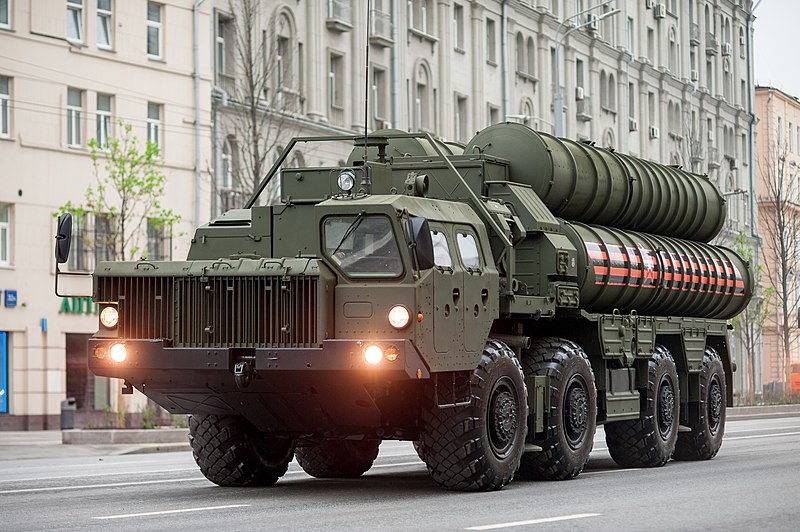
The system consists of a a radar set to find targets, another to track and engage targets, command-and-control, and finally the missile units above. A number of different missiles can be used, including one with a range of 400km and another with a range of 250km. Obviously I’m not privy to the locations of Russia’s SAM systems, but let me place four of them in hypothetical locations around Ukraine and you can see I’ve got pretty decent coverage of almost all Ukraine. Note that none of those four are actually located in Ukraine.
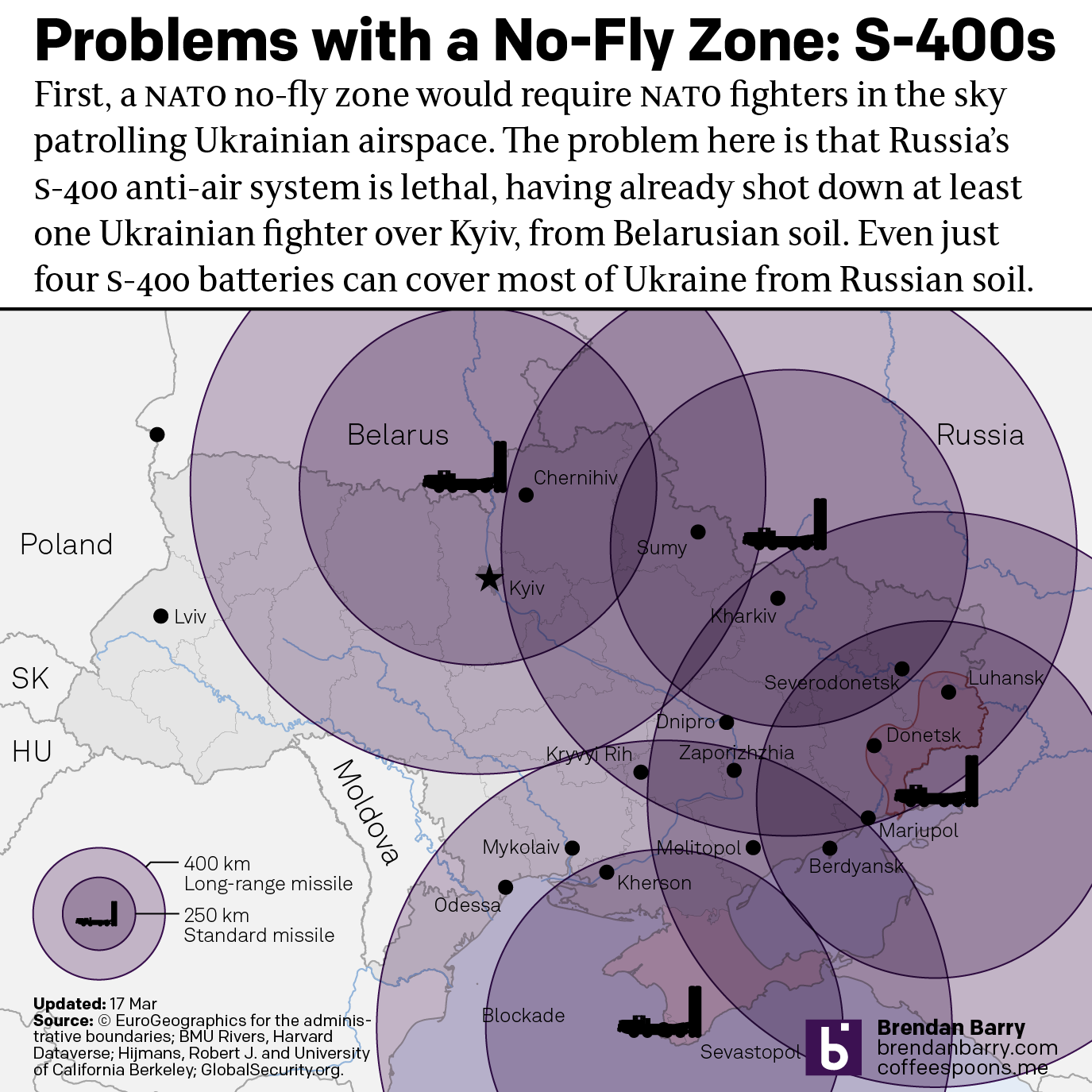
Most of the worst carnage Russia has inflicted on Ukraine is in cities like Mariupol and Kharkiv. You can see just how well those cities are covered in this hypothetical placement. I wouldn’t be surprised if Russia’s actual locations provide similar dense, overlapping coverage of those cities.
Now, at those longer ranges, it’s harder to hit targets flying low to the ground, e.g. an attack helicopter. So for a no-fly zone, NATO aircraft would have to fly over Ukraine to intercept any Russian fighters, bombers, helicopters or drones. To do that, however, NATO aircraft would have to fly higher up in the atmosphere where there’s less air resistance for more fuel economy and more radar coverage of the ground. That puts them squarely in the targets of these S-400s. Maybe NATO’s first flight goes off without a hitch. But the moment a NATO fighter shoots down a Russian fighter, these S-400s would likely start firing at NATO aircraft.
Thus a no-fly zone needs air superiority to be effective. And to control the skies over Ukraine, NATO would need to eliminate Russian SAM systems located within Russia and/or Belarus. To be clear, NATO would be bombing or using cruise missiles to kill Russians inside Russia.
Second, most of Russia’s killing of civilians is not done with bombs dropped from lanes. In recent days we have seen air-launched cruise missiles (ALCMs) destroy numerous targets. These present a distinct problem for no-fly zones as this graphic shows.
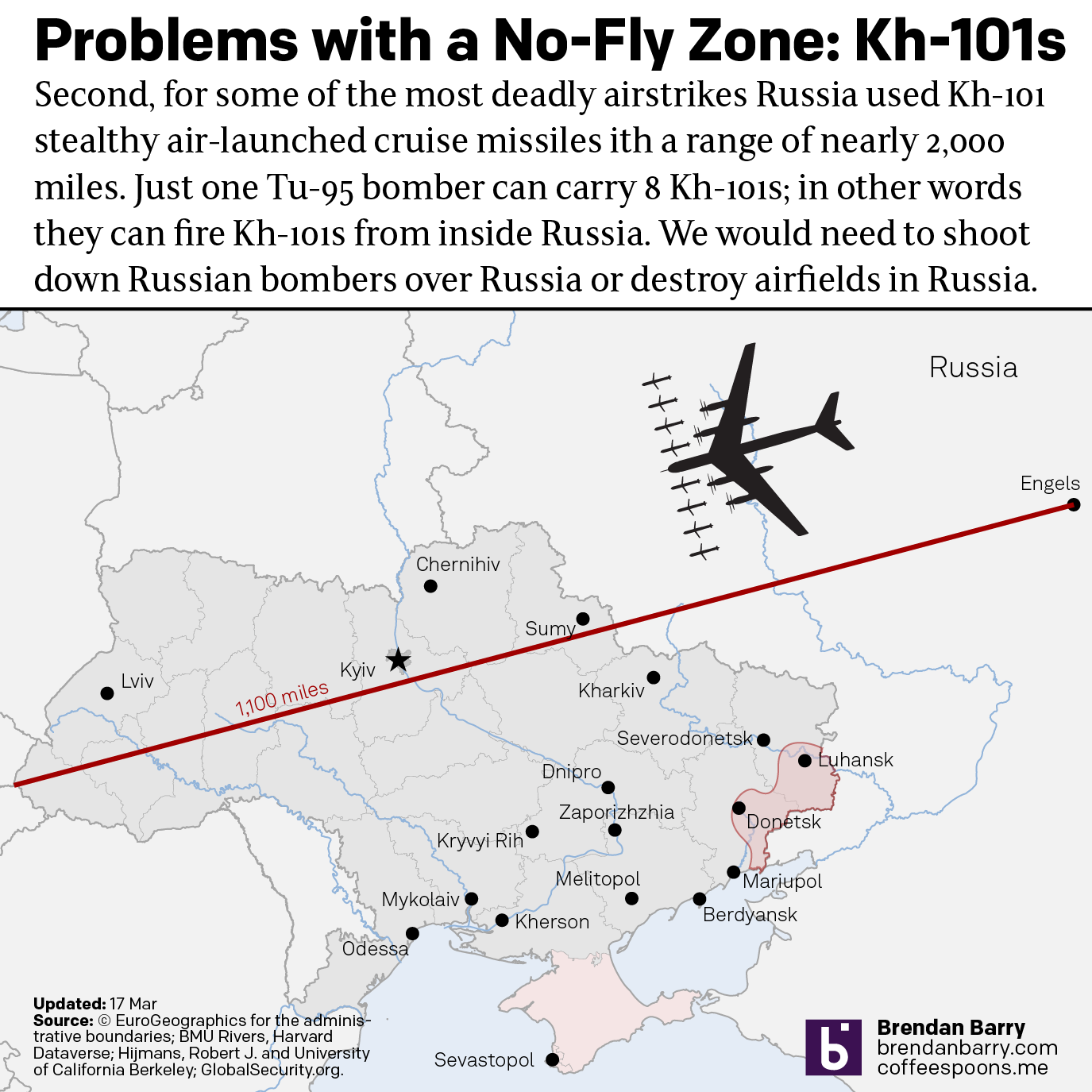
It is not easy to destroy an incoming missile, especially when they utilise countermeasures designed to trick defence systems or when the missile is designed for stealth. With the Kh-101 ALCM, Russia has a long-range stand-off weapon, meaning that it can fire the weapon from beyond a range where the Ukrainians can effectively defend against the unit firing the weapon.
The Kh-101 can be fired from a Tu-95 Bear, it’s kind of the Soviet/Russian version of the American B-52. It’s old, slow, but can hold a lot of weapons. And in this case one Bear can launch from their base in Engels, Russia with eight Kh-101s. With a missile range of 2,000 miles, Russia can fire Kh-101s and hit targets from well inside Russia.
For a no-fly zone this means you need the ability to shoot down those missiles at a bare minimum. But keep in mind, this is not easy to do. And so you would probably need to shoot down the Bears in flight or maybe even target the airfield runway, which is even further inside Russia than the SAM systems at which we just looked. More bombing of Russia.
Are you noticing a pattern yet?
Third, we also need to look at what’s actually causing some of the worst damage. Here you can see two of the culprits: a BM-21 Grad and 2S19M2 Msta-S. The first is a multiple launch rocket system (MLRS) and the second is a self-propelled artillery.
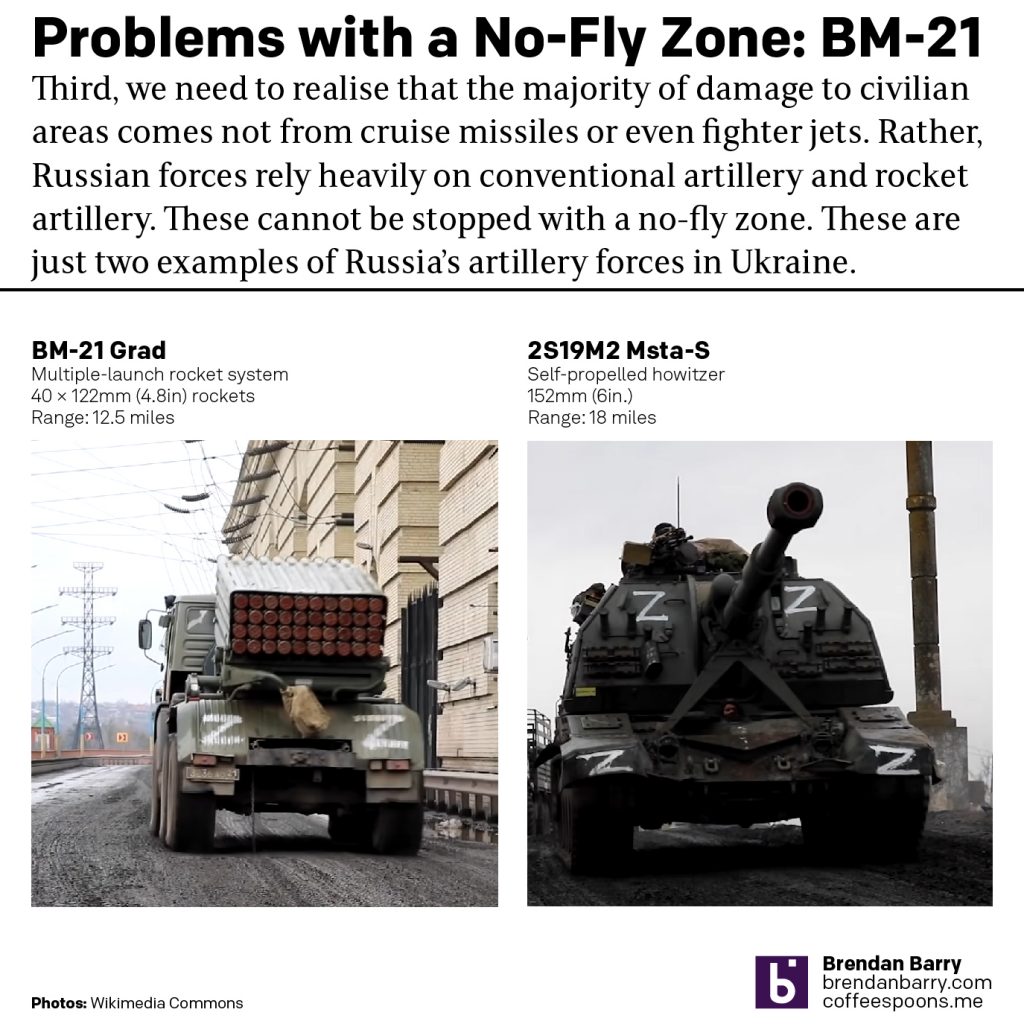
The MLRS does what it looks like it does. This model has forty rockets and it can very quickly launch all or just some of them. But it’s more of an area fire weapon, which means that it’s meant to saturate a target area with a lot of fire. Grad translates to Hail and you can get a sense from that word what the system is meant to do. The Msta-S is basically a big artillery gun put onto a tank’s body so that it can move around on its own without having to be towed into place. With the bigger gun, these things can do a lot of damage on their own.
Neither of them, however, would be defended against with a no-fly zone. To engage them would be more of a proper and conventional war, using aircraft and drones to take out targets of opportunity as they emerge from hiding places. Instead of just taking out Russian planes over Ukraine, Russian SAM sites on the Russian side of the Russo-Ukrainian border, and airfields deep inside Russia, now we’d be bombing Russian units operating on the ground in Ukraine.
A no-fly zone means war with Russia. And that’s bad, because Russia’s military is smaller and less capable than all of NATO, but Russia likely would not hesitate to use chemical, biological, or nuclear weapons against NATO targets should NATO become actively involved. Russia would then be effectively put into a corner and it has a sizeable stockpile of tactical nuclear weapons and has the doctrines to use them.
I don’t want to alarm people, so let’s take a brief aside to talk nukes. A tactical nuke is not the same thing as the nuclear weapons we associate with giant mushroom clouds obliterating entire cities. Those are strategic nuclear weapons deployed from an intercontinental ballistic missiles (ICBMs), which are themselves different from the short-range ballistic missiles Russia has been using throughout this war. A tactical nuclear weapon typically will have a size of 1 to 1,000 kilotons. A strategic weapon could be in the range of 30,000–50,000 kilotons (some smaller, some larger). For context, the bomb that the US dropped on Hiroshima was about 15 kilotons.
Even though the damage would be more confined to the battlefield, we really, really do not want a nuclear war. Radiation is still a thing. And the local effects would be catastrophic. Finally, if Russia deployed a nuclear artillery shell to eliminate a NATO armoured column advancing east from the Polish border, we would have to counter or risk continued Russian use of tactical nuclear weapons. And if we then take out a Russian tank regiment, what stops Russia from escalating to using a nuclear weapon on Polish soil to take out a NATO airbase. And then we take out one of those aforementioned Russian airbases. And then they respond with a nuclear weapon hitting Bratislava, warning us to stop. But NATO’s been nuked, so we respond and take out a smaller Russian city, maybe Rostov-on-Don or Murmansk. They then launch on New York. We respond overwhelmingly. They respond overwhelmingly. Nuclear winter descends upon the planet and lots and lots of people die.
Putin knows this escalatory ladder as well as we do. I don’t think Russia using tactical nuclear weapons is particularly high. But it’s not zero. And given how cataclysmic that non-zero risk is, it’s worth being more risk-averse in this war.
Back to the no-fly zones, to sum up, if NATO declares and then enforces a no-fly zone, NATO is declaring war on Russia. That’s bad because there’s an obvious if not highly likely route to escalation to complete thermonuclear war between the world’s two largest nuclear powers.
So, if a no-fly zone is a bad idea, what can we do? After all, it’s easy to say no and harder to offer an alternative.
The short version is to keep doing what we have been doing.
When President Biden announced the latest aid package from the US, he mentioned artillery radar amongst the thousands of missiles and other splashy hardware. Artillery radar, or counter-battery radar, may not be very sexy, but it is very important because it allows Ukrainians to detect incoming artillery and rocket fire from units like those BM-21s or Mstas. And once you detect those, you can pinpoint their location and direct your own artillery fire or send your aircraft or drones to take out Russian artillery. That would do the most to defend against Russian artillery.
Then there were a number of measures announced with respect to air defence systems and those fall into a number of categories.
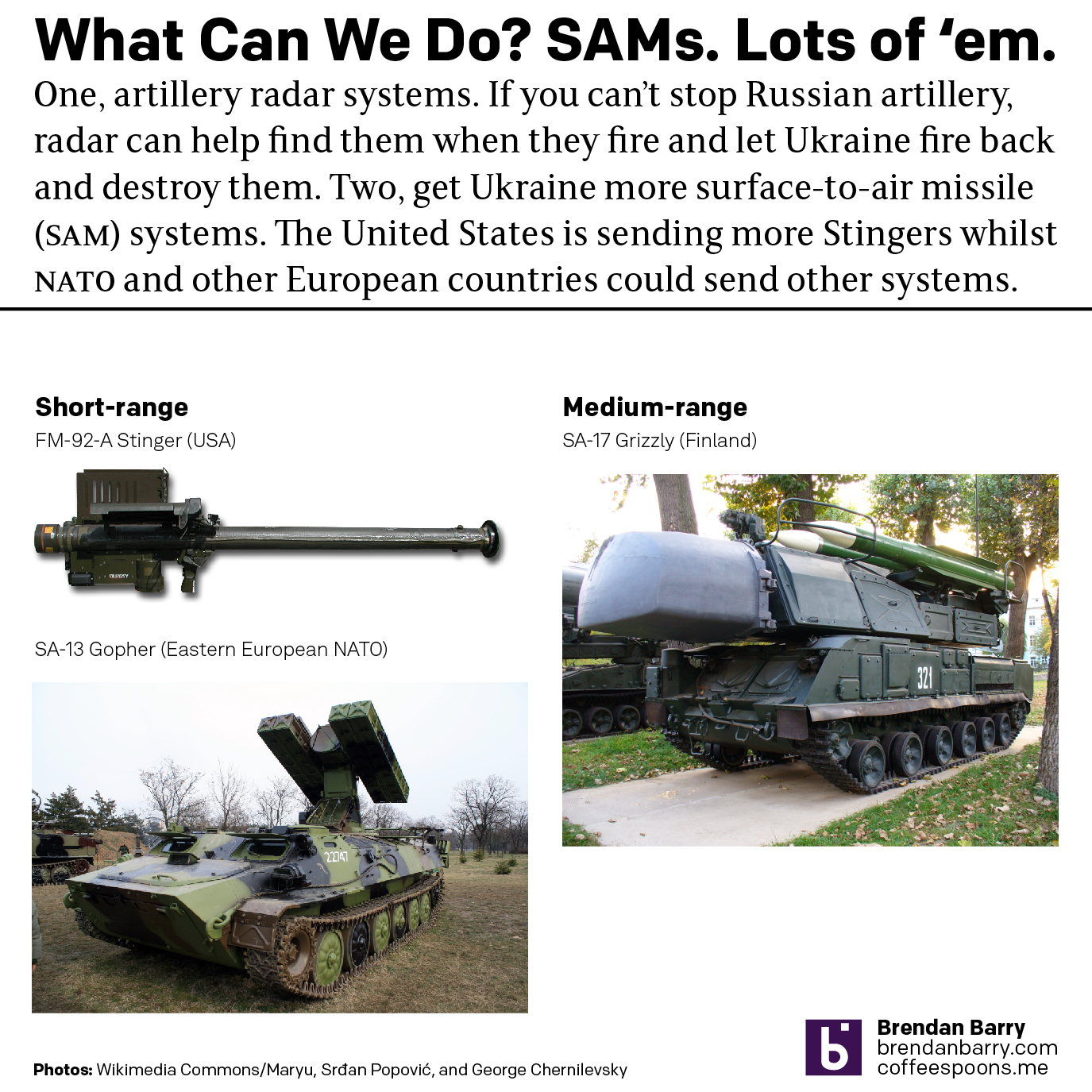
We have all heard about Stingers. Those are incredibly effective against Russian helicopters and low-flying aircraft and drones. But there are also other options, here I’ve depicted an SA-13 Gopher, which is a Soviet-made, i.e. Ukrainians know how to use them, which is in use by several Eastern European NATO countries. The United States cannot supply those. We do have a few systems given to us by those same countries so we can train against them, but I think it unlikely we give those up. But can the United States give those Eastern European NATO countries new American-made systems and then those older Soviet-made systems are given to Ukraine?
Top in this list are some S-300 missile systems, in particular owned by Slovakia. The Slovak defence minister announced that Slovakia is willing to immediately provide its S-300 system, but only if it can receive a replacement system from NATO. If you are Slovakia watching your neighbour be invaded by Russia, I think wanting a replacement system makes an immense amount of sense. Just yesterday, Germany and the Netherlands announced they’ll send their Patriot missile batteries to Slovakia. Once they arrive, hopefully Slovakia will follow through and send its system to Ukraine.

These systems differ in terms of what they can do to defend Ukraine’s skies. The Stingers and some of Ukraine’s own short- and medium-range systems can defend the battlefield, but the S-300 could help defend larger area of operations. Ukraine did have and operate the S-300 before the war, although there have been a number of photos of destroyed Ukrainian systems, probably taken out by Russia in the opening hours of the war. So any replacement systems would allow Ukraine to better intercept aircraft at longer ranges, but also cruise missiles like the ones we’ve been discussing.
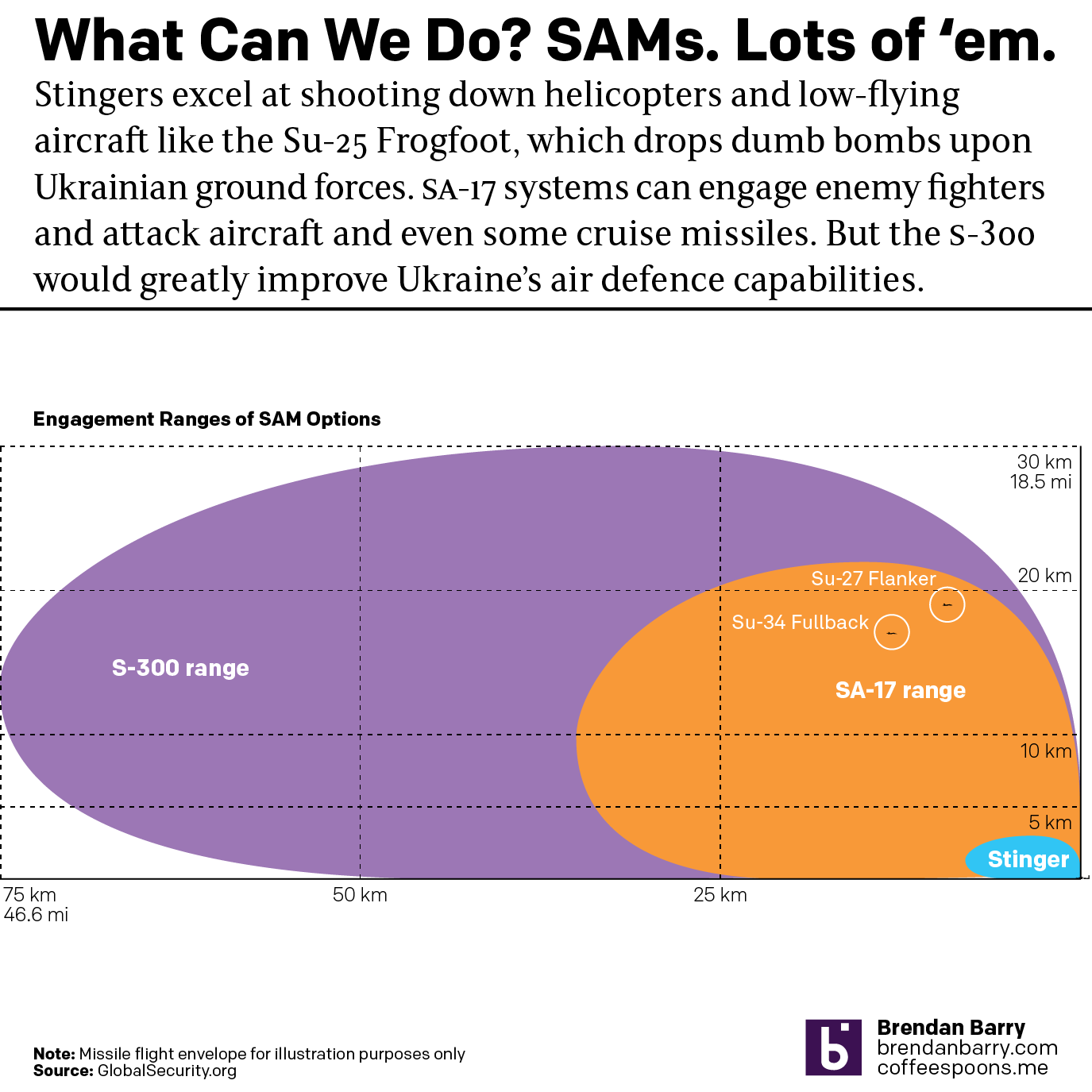
Ukraine has effectively used its air defence assets to deny air superiority to Russia. That doesn’t mean Russia doesn’t actively control parts of the sky, because it does, but Ukraine successfully contests that on a daily basis. You only need to look at the mounting numbers of aircraft, drones, and helicopters for proof of that.
Keep giving Ukraine SAMs and a lot of them. That’s the best way to “close the skies” over Ukraine.
Finally, I’ll add a few thoughts about those Polish MiGs, maybe 24 or so of them.
The MiGs are old planes compared to the front line fighters Russia has deployed to the conflict. Additionally, Russia does have airborne command-and-control assets to identify Ukrainian aircraft in the skies then vector those fighters to the area and take them out. MiGs do have some advantages: they can operate from dirt airfields and offer some air-to-ground capabilities. If they fly low enough they can mitigate some of the risk from Russia’s S-400s.
For Ukraine to try and achieve its own air superiority, it would need far more than 24 MiGs. At present, Ukraine flies only 5–10 sorties or missions per day. Russia is flying about 200. Ukrainian fighters would need to loiter in the skies over Ukraine, but we’ve already seen how Russia could shoot down those jets with their long-range SAMs. For Ukraine to establish air superiority it would need to do all the things we discussed earlier, but Ukraine has none of the tools to do that. Ukrainian air superiority is likely out of the question for the duration of the conflict.
So if Ukraine is restricted to low-altitude operations, NATO may have better options for Ukraine. Bulgaria has maybe 14 Su-25 Frogfoots. These excel at flying low and taking out ground units like tanks, artillery, infantry fighting vehicles, &c. The aircraft can be taken out by Russia’s own short- and medium-range air defence units deployed with Russian ground forces, but they can take more punishment than fighter jets.
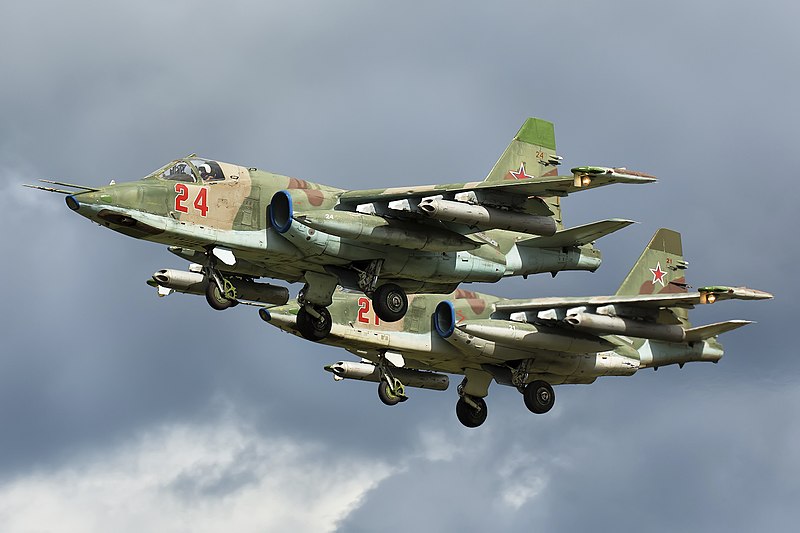
These would be far more useful than MiGs. As with the MiGs, however, 14 is not really a number that will change the balance of air power and we don’t even know if those Bulgarian planes are still capable of flying. Regardless, the ground-based SAM units would be the best bet along with the aforementioned artillery radar systems. If we can get more of those units to Ukraine, that would be immensely more helpful than maybe two dozen MiGs.
In other words, we’re doing the best we can do. Keep giving Ukraine all the missiles it can use. But a no-fly zone should remain off the table for now.
Credit for the work is mine.
